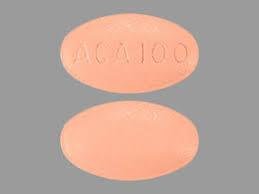Calquence Dosage
Generic name: ACALABRUTINIB 100mg
Dosage form: capsule, gelatin coated
Drug class: BTK inhibitors
Medically reviewed by Drugs.com. Last updated on Mar 13, 2024.
Recommended Dosage
CALQUENCE as Monotherapy
For patients with MCL, CLL, or SLL, the recommended dose of CALQUENCE is 100 mg taken orally approximately every 12 hours until disease progression or unacceptable toxicity.
CALQUENCE in Combination with Obinutuzumab
For patients with previously untreated CLL or SLL, the recommended dose of CALQUENCE is 100 mg taken orally approximately every 12 hours until disease progression or unacceptable toxicity. Start CALQUENCE at Cycle 1 (each cycle is 28 days). Start obinutuzumab at Cycle 2 for a total of 6 cycles and refer to the obinutuzumab prescribing information for recommended dosing. Administer CALQUENCE prior to obinutuzumab when given on the same day.
Advise patients to swallow capsule whole with water. Advise patients not to open, break or chew the capsules. CALQUENCE may be taken with or without food. If a dose of CALQUENCE is missed by more than 3 hours, it should be skipped and the next dose should be taken at its regularly scheduled time. Extra capsules of CALQUENCE should not be taken to make up for a missed dose.
Recommended Dosage for Hepatic Impairment
Avoid administration of CALQUENCE in patients with severe hepatic impairment.
Dose modifications are not required for patients with mild or moderate hepatic impairment [see Use in Specific Populations (8.6) and Clinical Pharmacology (12.3)].
Recommended Dosage for Drug Interactions
Dose Modifications for Use with CYP3A Inhibitors or Inducers
These are described in Table 1 [see Drug Interactions (7)].
|
CYP3A |
Co-administered Drug |
Recommended CALQUENCE use |
|
Inhibition |
Strong CYP3A inhibitor |
Avoid concomitant use. If these inhibitors will be used short-term (such as anti‑infectives for up to seven days), interrupt CALQUENCE. |
|
Moderate CYP3A inhibitor |
100 mg once daily. |
|
|
Induction |
Strong CYP3A inducer |
Avoid concomitant use. If these inducers cannot be avoided, increase CALQUENCE dose to 200 mg approximately every 12 hours. |
Concomitant Use with Gastric Acid Reducing Agents
Proton Pump Inhibitors: Avoid concomitant use [see Drug Interactions (7)].
H2-Receptor Antagonists: Take CALQUENCE 2 hours before taking a H2-receptor antagonist [see Drug Interactions (7)].
Antacids: Separate dosing by at least 2 hours [see Drug Interactions (7)].
Dose Modifications for Adverse Reactions
Recommended dose modifications of CALQUENCE for Grade 3 or greater adverse reactions are provided in Table 2.
|
Event |
Adverse Reaction Occurrence |
Dose Modification (Starting dose = 100 mg approximately every 12 hours) |
|
Grade 3 or greater non-hematologic toxicities, Grade 3 thrombocytopenia with bleeding, |
First and Second |
Interrupt CALQUENCE. Once toxicity has resolved to Grade 1 or baseline level, CALQUENCE may be resumed at 100 mg approximately every 12 hours. |
|
Grade 4 thrombocytopenia or Grade 4 neutropenia lasting longer than 7 days |
Third |
Interrupt CALQUENCE. Once toxicity has resolved to Grade 1 or baseline level, CALQUENCE may be resumed at a reduced frequency of 100 mg once daily. |
|
Fourth |
Discontinue CALQUENCE. |
|
|
Adverse reactions graded by the National Cancer Institute Common Terminology Criteria for Adverse Events (NCI CTCAE). |
||
Refer to the obinutuzumab prescribing information for management of obinutuzumab toxicities.
Frequently asked questions
More about Calquence (acalabrutinib)
- Check interactions
- Compare alternatives
- Pricing & coupons
- Reviews (18)
- Drug images
- Side effects
- During pregnancy
- FDA approval history
- Drug class: BTK inhibitors
- Breastfeeding
- En español
Patient resources
Professional resources
Related treatment guides
Further information
Always consult your healthcare provider to ensure the information displayed on this page applies to your personal circumstances.


